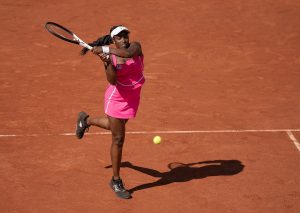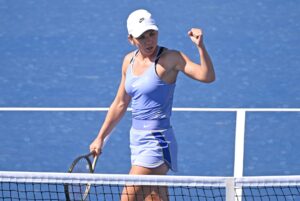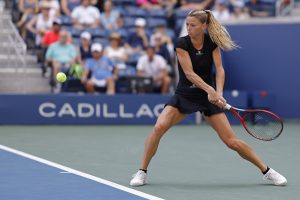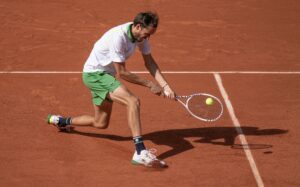Indian Wells may be generally regarded as “the Fifth Grand Slam,” as it is one of the few tournaments outside the official Majors that brings together the best male and female players at the same event, but it is still rare that a second-round women’s singles match there generates much interest. Nevertheless, that will be the case tonight when the two best British women, Johanna Konta and Heather Watson, face each other for the first time on the main tour, in what will be a rare British duel in the sun. What is at stake is not only the players’ immediate progression (or otherwise) at Indian Wells but Watson’s chances of meaningfully challenging Konta at the top of the women’s game.
The fact that Konta was given a first-round bye at Indian Wells while Watson won a hard-fought three-set match against America’s Nicole Gibbs to secure her own place in the second round in California says everything about the gulf between them in the world rankings that currently exists. Watson, having suffered a difficult few years–principally because she was laid low with glandular fever for a long time–is currently ranked outside the World top 100, while, Konta–after a near-miraculous rise through the women’s rankings in 2016–is ranked at No. 10. This disparity in their rankings would have seemed inconceivable a few years ago. Indeed, most tennis fans would have thought that Watson would have been ranked higher than Konta, as it was Watson who had enjoyed the far more successful junior career of the two, before making the early progress in the professional ranks that eluded Konta for a long time. In fact, the two women have experienced an almost complete reversal of fortune, with Konta’s achievements over the last year or so completely outstripping those of Watson.
There was certainly a considerable difference between the two players’ early careers. Watson was marked out as a future star, almost from the start, following the classic trajectory of a young tennis player by training at the Nick Bollettieri academy in Florida before winning the 2009 US Open Girl’s Singles crown. Consequently, when she turned professional the following year the hopes for her were high, especially in her native country, which had finally discovered a great male player in Andy Murray but still yearned for a great female player to match the mighty achievements of Anne Jones, Virginia Wade and Sue Barker–Grand Slam winners all–in the increasingly distant past.
By contrast, Konta followed a career path that was far closer to that of the “third woman” of British tennis, Laura Robson, than that of Watson. Like Robson, who was born in Australia and raised there until she was in her teens, Konta–the daughter of Hungarian immigrants to Australia–also represented Australia initially, before she, too, moved to the United Kingdom and ultimately became a British citizen.
Unlike both Watson and Robson, who were both junior Grand Slam Champions (Robson triumphing at Wimbledon in 2008, when she was only 14), it is fair to say that Konta was not marked out as a future star right from the start. She did not excel at junior level and instead maintained a slow–at times, agonisingly slow–rise up the world rankings until last year, when she suddenly sky-rocketed to the top of the women’s game. What is fascinating is that a large part of that meteoric success was attributable, as Konta herself admitted, not to any sudden acquisition of power or change of technique but to an immeasurable improvement in her mental resolve. This was achieved mainly as a result of her working closely with Juan Coto, a self-professed “mental coach” who concentrated not on improving her backhand or forehand but her tennis brain.
It is one of the great clichés of tennis that it is ultimately a game played in the mind, but in Konta’s case it appears to be true. Her work with Coto, for about 18 months from the end of 2014 onwards, yielded immense dividends almost immediately. She went from being a fundamentally “flaky” player who could beat anyone but also lose to anyone to one of the very toughest competitors on the circuit, who suddenly possessed what is possibly the most priceless ability in tennis–the ability to play each point, one by one, until the match is over, instantly forgetting both mistakes and any successful shots.
When Coto unexpectedly and tragically died at the end of 2016–the year in which Konta had followed up reaching the semifinals at the Australian Open by advancing into the World’s top 10 and only narrowly missing out on the end-of-year tour finals–it was feared that there might be a disastrous effect on her form. However, as if to prove the lasting benefits of Coto’s work with her, Konta has continued to prove herself the doughtiest of challengers; and if she could not quite match last year’s achievement of making the last four at Melbourne, that was only because she came up against the peerless Serena Williams in the quarterfinal, and afterwards even Serena was moved to say how impressed she was by Konta and tipped her as a possible future winner of the Australian Open (although, presumably, not until she herself retires).
The loss of Coto can be considered doubly tragic because it is possible that, in time, he might have been asked to work with other British players, notably Watson and Robson, by the LTA and in particular by Great Britain’s new Fed Cup captain, Anne Keothavong. Keothavong herself was almost the embodiment of the talented but tortured British woman player, who invariably lost matches she should have won because of her inability to “stay in the moment” and “play each point as it comes.” Keothavong has already achieved great things with the Fed Cup team, leading them through last month’s qualifying tournament in Estonia to a World Group play-off match against Romania next month, the first time that Britain has reached that level since 1993.
For now, however, it will be fascinating to see how Konta and Watson face off against each other at Indian Wells. Konta will undoubtedly be the favourite, but Watson will be itching to prove that she is the equal of her Fed Cup teammate. Whatever the result, it augurs well for British women’s tennis, and in particular for the crucial play-off game against Romania. If Konta can maintain her form of 2016, if Watson can rise to the challenge that has been thrown down by Konta, and if–and this is the biggest if of all–Laura Robson can finally overcome her own crippling injury problems, Britain can genuinely entertain hopes of beating Romania, even if Simone Halep plays, and possibly even competing at the very top of the women’s game for the first time in decades.
Main Photo:






